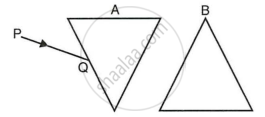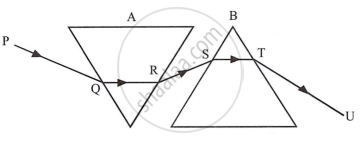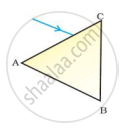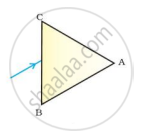Advertisements
Advertisements
प्रश्न
In following figure shows two identical prisms A and B placed with their faces parallel to each other. A ray of light of single colour PQ is incident at the face of the prism A. Complete the diagram to show the path of the ray till it emerges out of the prism B.

[Hint: The emergent ray out of the prism B will be parallel to the incident ray PQ]
उत्तर
The emerging ray, TU, eventually lies parallel to PQ after bending twice as it passes through prisms A and B, respectively, towards their respective bases.

APPEARS IN
संबंधित प्रश्न
Define the term angle of deviation.
A ray of light is normally incident on one face of an equilateral glass prism. Answer the following:
What is the angle of incidence on the first face of the prism?
A ray of light is normally incident on one face of an equilateral glass prism. Answer the following:
Will the light ray suffer minimum deviation by the prism?
A ray of light suffers refraction through an equilateral prism. The deviation produced by the prism does not depend on the ______.
When white light enters a prism, it gets split into its constituent colours. This is due to:
A prism ABC (with BC as base) is placed in different orientations. A narrow beam of white light is incident on the prism as shown in below Figure. In which of the following diagrams, after dispersion, the third colour from the top of the spectrum corresponds to the colour of the sky?
How will you use two identical prisms so that a narrow beam of white light incident on one prism emerges out of the second prism as white light? Draw the diagram.
Draw a ray diagram showing the dispersion through a prism when a narrow beam of white light is incident on one of its refracting surfaces. Also indicate the order of the colours of the spectrum obtained.
State three factors on which the angle of deviation depends.
Name the colour of white light which is deviated the least on passing through a prism.




